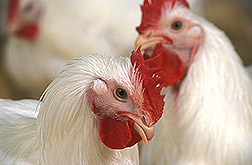Science Update
Dietary Protein’s Okay for Bones
Scientists once thought that high-protein diets might lead to greater calcium excretion and threaten bone health, especially in postmenopausal women. So they tested diets that were high or low in meat protein. Results did not bear out the theory: Volunteers retained calcium just as well from either diet.
More recently, animal- and vegetable-protein diets were compared to see whether either protein source caused greater calcium excretion. Both diets provided an average amount of protein for U.S. diets—15 percent of total calories. One contained mostly meat protein; the other substituted 25 grams of high-isoflavone soy protein for an equivalent amount of meat protein each day. Otherwise, the two diets were similar, including a variety of ingredients and typical amounts of calcium and other nutrients. Postmenopausal women absorbed and retained similar amounts of calcium from both diets.
Both studies showed that calcium nutrition of postmenopausal women was neither enhanced nor impaired by increasing meat consumption or by interchanging soy protein and meat protein.
Janet Ross Hunt, USDA-ARS Grand Forks Human Nutrition Research Center, Grand Forks, North Dakota; phone (701) 795-8328.
A Human Fungicide . . . for Plants?
A naturally occurring compound called sampangine, patented in 1990 to treat human fungal infections, has been patented again for another use. It and similar, related compounds may have use as low-toxicity, broad-spectrum controls of fungal plant pathogens that threaten agriculture.
Sampangine-based compounds have been shown to control fungi such as Botrytis cinerea, which causes gray mold on tomatoes; Colletotrichum fragariae, which causes anthracnose crown rot and wilt in strawberry plants; and Fusarium oxysporum, which causes vascular wilt in crops such as potatoes, sugarcane, and many ornamentals. These antifungal compounds may boost the $31-billion annual “minor crop” industry by helping to manage fungicide-resistant diseases both before and after harvest. The research is being done with Icoria Inc., of Research Triangle Park, North Carolina.
David F. Wedge, USDA-ARS Natural Products Utilization Research Unit, Oxford, Mississippi; phone (662) 915-1137.
|
|
And Now, Feather-Based Plastics
A patent application for converting cleaned and chopped feather material into plastic products—on a laboratory scale—has been filed by scientists seeking new uses for some of the nearly 4 billion pounds of poultry feathers generated each year in the United States alone. The feather-based plastic can be made on traditional processing equipment and molded just like any other plastic. Its properties are very similar to commodity petroleum-based plastics such as polyethylene and polypropylene. Feather-derived plastic would be a unique material for packaging or any other application where high strength and biodegradability are desired.
Inorganic materials such as glass, talc, mica, and calcium carbonate are additives and fillers currently used in plastics for, say, the auto industry, and add significant weight to parts. The easily extracted fiber portion of the feathers would be a viable alternative, retaining the properties of those additives but significantly reducing weight. Not only would feather-based plastics help solve an environmental problem, it would increase commercial and economic value of a natural renewable polymer resource—feathers.
Walter F. Schmidt and Justin Barone, USDA-ARS Environmental Quality Laboratory, Beltsville, Maryland; phone (301) 504-6765 [Schmidt], (301) 504-5905 [Barone].
Oats are much less winter hardy than other fall-sown grain crops, such as wheat, barley, or rye. Yield losses are common when temperatures dip below 20˚F and persist. But recently, two oat genotypes were identified that were more freeze-tolerant, under controlled freeze tests, than any variety released during the past 65 years. To find them, researchers screened 10,000 offspring of a cross between two historic U.S. winter oats—Wintok (released in 1940) and Norline (released in 1960). The two most hardy lines they called WN1 and WN10.
Neither of these lines is late-flowering, a trait usually linked to freeze tolerance. They seem to have regenerative cells within their crowns that sufficiently resist ice and cold to regrow after winter. Breeders are now crossing the new germplasm with high-yielding, disease-resistant commercial varieties. Increasing oats’ winter hardiness could one day allow farmers as far north as Pennsylvania and Ohio to grow winter oats.
David P. Livingston, USDA-ARS Plant Science Research Laboratory, Raleigh, North Carolina; phone (919) 515-4324.
"Science Update" was published in the September 2005 issue of Agricultural Research magazine.







